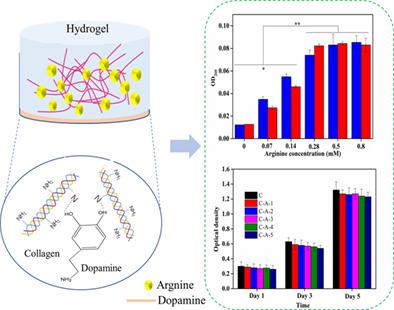当前位置:
X-MOL 学术
›
J. Appl. Polym. Sci.
›
论文详情
Our official English website, www.x-mol.net, welcomes your
feedback! (Note: you will need to create a separate account there.)
Fabrication and insights into the mechanisms of collagen-based hydrogels with the high cell affinity and antimicrobial activity
Journal of Applied Polymer Science ( IF 2.7 ) Pub Date : 2021-09-12 , DOI: 10.1002/app.51623 Shichen Zhu 1, 2 , Jiehang Yu 1, 2 , Shanbai Xiong 3 , Yuting Ding 1, 2 , Xuxia Zhou 1, 2 , Yang Hu 3 , Wenxin Chen 3 , Yuanli Lin 3 , Linrui Dao 3
Journal of Applied Polymer Science ( IF 2.7 ) Pub Date : 2021-09-12 , DOI: 10.1002/app.51623 Shichen Zhu 1, 2 , Jiehang Yu 1, 2 , Shanbai Xiong 3 , Yuting Ding 1, 2 , Xuxia Zhou 1, 2 , Yang Hu 3 , Wenxin Chen 3 , Yuanli Lin 3 , Linrui Dao 3
Affiliation

|
In this study, the adhesive collagen-based hydrogels with antibacterial ability were prepared via arginine and dopamine modification, and the corresponding characterizations were also performed. A significant increase of N atom content from guanidine group was found via X-ray photoelectron spectroscopy (XPS), suggesting the guanidine groups were successfully introduced into the systems. The XRD and FTIR patterns indicated that arginine and dopamine did not interrupt the intact triple-helix conformation of collagen. Both the thermal stability and dynamic modulus of collagen hydrogels first increased and then decreased with the rising introduction of arginine. The increasing attachment of arginine retarded the further aggregations of collagen molecules due to the enhanced electrostatic repulsion, which was also confirmed by the microstructure observed by SEM. The antimicrobial activity of hydrogels modulus intensified significantly with the initial introduction of arginine (0.07 ~ 0.28 mM) (p < 0.05) via the measurements of inhibition zone diameter and OD260 value. However, the further addition of arginine did not result in the significant changes in the antibacterial performance. The biocompatibility of collagen hydrogels was not compromised, while the cell adhesiveness was improved. This work may provide a new strategy for the design of collagen-based antibacterial hydrogels for the wound dressing applications.
中文翻译:

具有高细胞亲和力和抗菌活性的胶原基水凝胶的制备和机制
在本研究中,通过精氨酸和多巴胺修饰制备了具有抗菌能力的粘性胶原基水凝胶,并进行了相应的表征。通过X射线光电子能谱(XPS)发现胍基团的N原子含量显着增加,表明胍基团已成功引入系统。XRD 和 FTIR 模式表明精氨酸和多巴胺不会中断胶原蛋白的完整三螺旋构象。随着精氨酸的引入,胶原蛋白水凝胶的热稳定性和动态模量均先升高后降低。由于静电排斥力的增强,精氨酸的增加阻止了胶原分子的进一步聚集,SEM观察到的微观结构也证实了这一点。随着精氨酸(0.07 ~ 0.28 mM)的初始引入,水凝胶模量的抗菌活性显着增强(p < 0.05) 通过抑菌圈直径和 OD 260值的测量。然而,进一步添加精氨酸并没有导致抗菌性能的显着变化。胶原水凝胶的生物相容性没有受到影响,而细胞粘附性得到了提高。这项工作可能为用于伤口敷料应用的胶原基抗菌水凝胶的设计提供新的策略。
更新日期:2021-11-01
中文翻译:

具有高细胞亲和力和抗菌活性的胶原基水凝胶的制备和机制
在本研究中,通过精氨酸和多巴胺修饰制备了具有抗菌能力的粘性胶原基水凝胶,并进行了相应的表征。通过X射线光电子能谱(XPS)发现胍基团的N原子含量显着增加,表明胍基团已成功引入系统。XRD 和 FTIR 模式表明精氨酸和多巴胺不会中断胶原蛋白的完整三螺旋构象。随着精氨酸的引入,胶原蛋白水凝胶的热稳定性和动态模量均先升高后降低。由于静电排斥力的增强,精氨酸的增加阻止了胶原分子的进一步聚集,SEM观察到的微观结构也证实了这一点。随着精氨酸(0.07 ~ 0.28 mM)的初始引入,水凝胶模量的抗菌活性显着增强(p < 0.05) 通过抑菌圈直径和 OD 260值的测量。然而,进一步添加精氨酸并没有导致抗菌性能的显着变化。胶原水凝胶的生物相容性没有受到影响,而细胞粘附性得到了提高。这项工作可能为用于伤口敷料应用的胶原基抗菌水凝胶的设计提供新的策略。











































 京公网安备 11010802027423号
京公网安备 11010802027423号